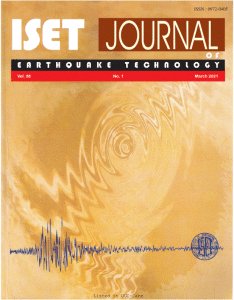Home > Issues & Journals
A Modal Combination Rule for Ordered Peak Response under Multi-Component Ground Motion
Ayan Sadhu and Vinay K. Gupta
Paper No.: 499
|
Vol.: 45
|
No.: 3-4
|
December, 2008
|
pp. 77-94

Abstract
The traditional earthquake-resistant design philosophy involves estimation of the peak elastic response for the specified seismic hazard, which in turn requires a modal combination rule for the multi-degree-of-freedom systems. The typically used rules estimate just the largest response peaks, while the second largest, third largest, … peaks are assumed to be of no significance. Considering the possibility that structural damage in the post-yield regime can be correlated with these higher order peaks, a new modal combination rule is developed for the ordered peak response of multistoried buildings excited by the multi-component ground motions. The proposed rule is formulated by using the stationary random vibration theory and by making suitable approximations regarding the peak factors and nonstationarity factors. A numerical study shows that the proposed rule performs better than the CQC3 rule when the building is stiffer to the ground motion and that the level of accuracy for the higher order peaks up to the 10th largest peak is comparable to that for the largest peak.
Keywords: Multi-Degree-of-Freedom Systems, Multi-component Ground Motions, Higher Order Peaks, Order Statistics, Modal Combination Rule
©2025. ISET. All Rights Reserved.